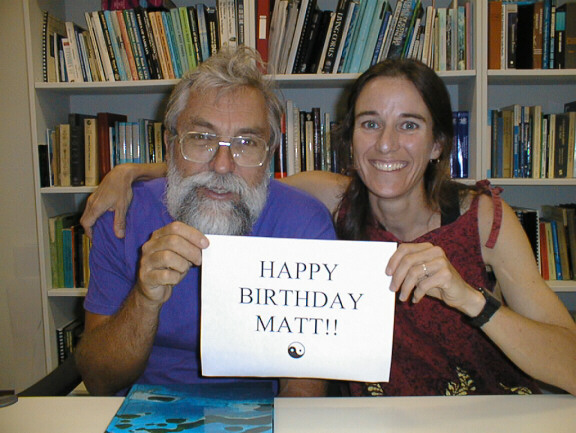Daily Log Report for
14
May 1997
Submitted by Richard Pyle
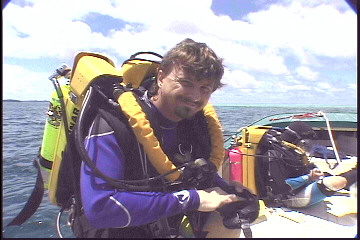 The
weather was perfect -- the best conditions so far during
this expedition. The film crew had gone back to the south
end of Palau to get more general reef-fish sequences
(sharks, rays, turtles, etc.), so John, Pat, Lisa and I
decided to make a mid-day dive at our "usual"
spot at Augulpelu Reef. We had several tasks to complete.
My mission was to take the video camera and get sequences
for a local television station back in Hawaii
(particularly of the deep ledge, and us collecting
fishes). We also wanted to recover the trap I had placed
in a cave two days ago. Finally, we wanted to send
another bag full of rocks and rubble back to the surface
for Pat & Lori to pick through (looking for
interesting critters). The plan was for me to go down
first, starting from the boat and descending directly
(non-stop) to the terrace at 300 feet, where I would film
the marine life while I waited for John to catch up with
me. When he arrived, I would film him recovering the
trap, then film him sending rocks to the surface with the
lift-bag, then film him collecting fish. At some point we
would trade-off and he would film me collect fish. Pat
would come down with John, leave the nitrox bailout
cylinder at 100 feet, then spend his bottom time
collecting large oysters in a small cave at 200 feet.
The
weather was perfect -- the best conditions so far during
this expedition. The film crew had gone back to the south
end of Palau to get more general reef-fish sequences
(sharks, rays, turtles, etc.), so John, Pat, Lisa and I
decided to make a mid-day dive at our "usual"
spot at Augulpelu Reef. We had several tasks to complete.
My mission was to take the video camera and get sequences
for a local television station back in Hawaii
(particularly of the deep ledge, and us collecting
fishes). We also wanted to recover the trap I had placed
in a cave two days ago. Finally, we wanted to send
another bag full of rocks and rubble back to the surface
for Pat & Lori to pick through (looking for
interesting critters). The plan was for me to go down
first, starting from the boat and descending directly
(non-stop) to the terrace at 300 feet, where I would film
the marine life while I waited for John to catch up with
me. When he arrived, I would film him recovering the
trap, then film him sending rocks to the surface with the
lift-bag, then film him collecting fish. At some point we
would trade-off and he would film me collect fish. Pat
would come down with John, leave the nitrox bailout
cylinder at 100 feet, then spend his bottom time
collecting large oysters in a small cave at 200 feet.
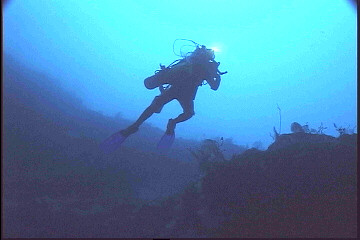 The first
part of the dive went like clockwork. I descended all the
way from the surface to the terrace without stopping,
filming all the while. I spent a good 10 minutes on the
terrace filming an assortment of things, and then I saw
John up at 200 feet, descending over the top of the upper
drop. He came down and I filmed him the whole time, but
he seemed to be coming awfully slowly. When he finally
reached me and dropped off the trimix bailout cylinder
and lift-bag apparatus, he indicated to me that the
nitrogen in his trimix diluent supply was too high, so he
was feeling rather severe narcosis. He opted to return to
220 feet and wait for me, leaving me with the bailout
cylinder and the lift-bag apparatus so I could complete
the mission. I left the bailout cylinder and swam over to
the trap. Before recovering it, I looked around inside
the cave and saw an assortment of interesting
invertebrate life. After a few minutes I returned to the
bailout trimix cylinder and lift-bag apparatus. I placed
the camera on the reef and positioned it in such a way
that I could film myself load the rocks and send them to
the surface.
The first
part of the dive went like clockwork. I descended all the
way from the surface to the terrace without stopping,
filming all the while. I spent a good 10 minutes on the
terrace filming an assortment of things, and then I saw
John up at 200 feet, descending over the top of the upper
drop. He came down and I filmed him the whole time, but
he seemed to be coming awfully slowly. When he finally
reached me and dropped off the trimix bailout cylinder
and lift-bag apparatus, he indicated to me that the
nitrogen in his trimix diluent supply was too high, so he
was feeling rather severe narcosis. He opted to return to
220 feet and wait for me, leaving me with the bailout
cylinder and the lift-bag apparatus so I could complete
the mission. I left the bailout cylinder and swam over to
the trap. Before recovering it, I looked around inside
the cave and saw an assortment of interesting
invertebrate life. After a few minutes I returned to the
bailout trimix cylinder and lift-bag apparatus. I placed
the camera on the reef and positioned it in such a way
that I could film myself load the rocks and send them to
the surface.
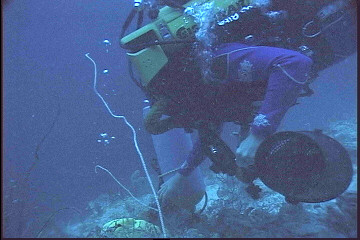 As soon as
I placed the camera, I suddenly noticed strong breathing
resistance. On the next breath, I absolutely could not
inhale! I tried again, this time with much more force,
but still to no avail. It was obvious that something was
drastically wrong with the rig, so I switched to my
open-circuit bailout, swam to the trimix bailout
cylinder, gathered all my gear (except for the lift-bag
apparatus), and started my ascent toward John (the
adjacent photo shows the actual bailout event, as I swam
over to the bailout trimix cylinder while the camera was
still on). By the time I caught up with John at about 220
feet, he already knew what was going on (he even offered
me his backup gas supply, but I declined because I had
plenty. After settling down for a moment at 220 feet, I
started filming John trying to collect fish up at 220
feet (as was the original plan). This may seem like
strange behavior in the midst of a serious bailout
situation, but the fact was that there was no need to
panic, I needed to complete my deep decompression stop at
about that depth anyway, so while we were sitting there,
it seemed appropriate to make good use of the time.
As soon as
I placed the camera, I suddenly noticed strong breathing
resistance. On the next breath, I absolutely could not
inhale! I tried again, this time with much more force,
but still to no avail. It was obvious that something was
drastically wrong with the rig, so I switched to my
open-circuit bailout, swam to the trimix bailout
cylinder, gathered all my gear (except for the lift-bag
apparatus), and started my ascent toward John (the
adjacent photo shows the actual bailout event, as I swam
over to the bailout trimix cylinder while the camera was
still on). By the time I caught up with John at about 220
feet, he already knew what was going on (he even offered
me his backup gas supply, but I declined because I had
plenty. After settling down for a moment at 220 feet, I
started filming John trying to collect fish up at 220
feet (as was the original plan). This may seem like
strange behavior in the midst of a serious bailout
situation, but the fact was that there was no need to
panic, I needed to complete my deep decompression stop at
about that depth anyway, so while we were sitting there,
it seemed appropriate to make good use of the time.
We worked our way up to the nitrox bailout cylinder, where I started trying to figure out what had just happened. It was obvious that my breathing loop had flooded, but where? Then it struck me! There is a small drain cap at the bottom of the breathing loop (where the CO2 canister is housed) on the rebreather I am using. It was originally designed to allow us an easy way to dump condensation out of the rig at the end of a dive. Bill Stone, the rebreather designer, originally built it so that it was physically impossible to put the back shell on the rebreather without first closing this drain cap. Bill had asked me to pay particular attention to this feature, and let him know if it was possible to get the back shell back on without the cap in place. I didn't pay much attention to this request, figuring it would take a real moron to forget to put the cap back on in the real world. Well...guess who's the moron! Yes, I had forgotten to replace this cap, and the breathing loop eventually flooded, preventing my ability to breathe! When I realized this was the problem, I called John over and asked him to replace the cap. Once he did, it was an easy matter to flush the water out of the breathing loop, and I was able to complete the full decompression without even the slightest breathing resistance.(In fact, I plan to use the same CO2 absorbent canister again for tomorrow's dive, without re-packing).
A stupid, careless mistake on my part very nearly put me in a tight predicament. Overall, however, I am pleased, because it allowed me to test our bailout plan, under real-world conditions, alone (without help), and under heavy task loading (filming, recovering trap, dealing with a lift-bag of rocks, etc.). What amazed me the most was how incredibly easy the bailout procedure was, even under these conditions. I was never worried - not even for a moment. Neither was John -- without communicating, we both knew he should try to catch fish while I filmed - even though I was breathing from the bailout cylinder. All things, considered, I'm encouraged!
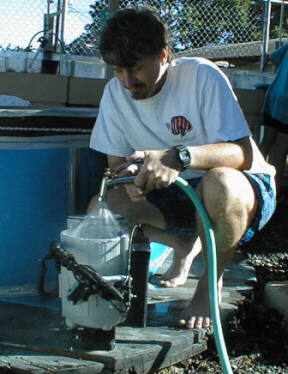 I spent
the rest of the decompression cruising around with Lisa,
looking at fish. It was extremely enjoyable, and when we
returned to the boat, the weather was just as beautiful
as we had left it. All in all, a wonderful day....until
we got back to the pier, that is. Upon opening my
underwater video housing, I found several tablespoons of
seawater inside! Fortunately, the gods of underwater
photography were smiling on me this day, because the
brand-new, un-insured Sony digital camera was just fine -
it had barely gotten wet. The housing itself was another
story. Basically, I've spent the last 6 hours
disassembling every component, checking for possible
signs of leaks and cleaning out the seawater. Upon
reviewing the tape taken today on that camera, the audio
portion abruptly stopped about half-way through the
bottom-time. Closer inspection suggested strongly that it
was the external microphone that had flooded, so tomorrow
Pat and I will try to replace it with a plug. Of course,
we'll leak-test it before putting the camera inside!
I spent
the rest of the decompression cruising around with Lisa,
looking at fish. It was extremely enjoyable, and when we
returned to the boat, the weather was just as beautiful
as we had left it. All in all, a wonderful day....until
we got back to the pier, that is. Upon opening my
underwater video housing, I found several tablespoons of
seawater inside! Fortunately, the gods of underwater
photography were smiling on me this day, because the
brand-new, un-insured Sony digital camera was just fine -
it had barely gotten wet. The housing itself was another
story. Basically, I've spent the last 6 hours
disassembling every component, checking for possible
signs of leaks and cleaning out the seawater. Upon
reviewing the tape taken today on that camera, the audio
portion abruptly stopped about half-way through the
bottom-time. Closer inspection suggested strongly that it
was the external microphone that had flooded, so tomorrow
Pat and I will try to replace it with a plug. Of course,
we'll leak-test it before putting the camera inside!
During the ascent, John brought up with him a huge starfish. During the melee of my bailout, he accidentally set the starfish down and neglected to pick it up again. All this was visible on the video I took, so Pat (who had a successful dive collecting oysters with his home-built rebreather) went back this afternoon and did a bounce dive to 100 feet, where he found it and brought it back to the surface.
Tomorrow, the film crew wants to interview me and Jack Randall. If there is time afterward, we'll do another deep dive to recover the lift-bag apparatus where I left it on the terrace. Watch this space...
One last thing....Pat and Lori had a special message to send today:
